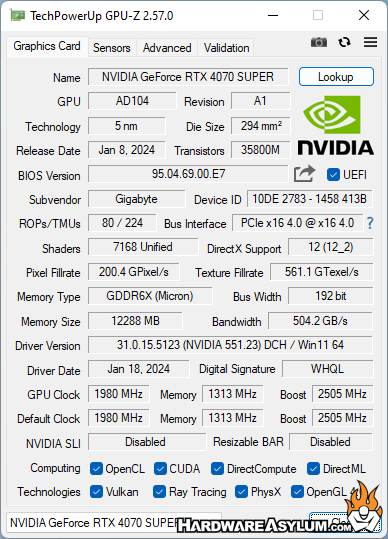Gigabyte RTX 4070 Super Windforce Overclock Video Card Review
Author: Darren McCainBenchmark Configuration
Z790 Aorus Elite X WiFi 7 – Z790 Chipset
Intel Core i9 14900k (3.0Ghz) Twenty Four Core 8 x 48KB L2 Cache 8 x 2MB L3 Cache 36MB
Cooler Master MasterLiquid PL360 Flux
1x nVidia RTX 4070
2x Patriot Viper Venom PC5-57600 DDR5 32GB (40-40-40-77)
Patriot P200 512GB SSD
Thermaltake Toughpower PF3 1050 Watt PSU
Windows 11 Pro 64bit
Drivers
Gigabyte RTX 4070 Super OC (551.61)
NVIDIA RTX 4070 (531.68)
NVIDIA RTX 3070 Ti (466.61)
NVIDIA RTX 2080 Super (466.27)

Framerates were captured using the included benchmarking software and captured game data. The settings used for each test will be listed on the individual benchmarking page with the average framerate recorded in the charts. When possible, only the GPU scores are recorded giving the best opportunity for repeatable results.
The purpose of our benchmark suite is to provide the readers with a comparative analysis of video card performance based on a common set of variables. This may not always reflect a real "in-game" experience or framerates, since those are almost impossible to replicate, but instead is designed to provide an accurate scale of performance of one video card to another given their default setting.
I also want to mention that very few of these benchmarks focus on Ray Tracing or DLSS. Much like with PhysX it is just a technology that will only run on a certain hardware platform. In this case Ray Tracing and DLSS will only run on RTX video cards and need to be enabled in a few select games and benchmarks to work properly.
I am a big fan of the performance gains from RTX but to be honest it is very difficult to discern an RTX feature in games. RTX isn’t like PhysX where you could easily tell when a PhysX feature was enabled as they are currently focused on shadows, reflections, lighting and the antialiasing of the scene. If the game developer does a good job, these features become increasingly difficult to spot. This is a good thing and we can see how RTX features are simply improving on that.

